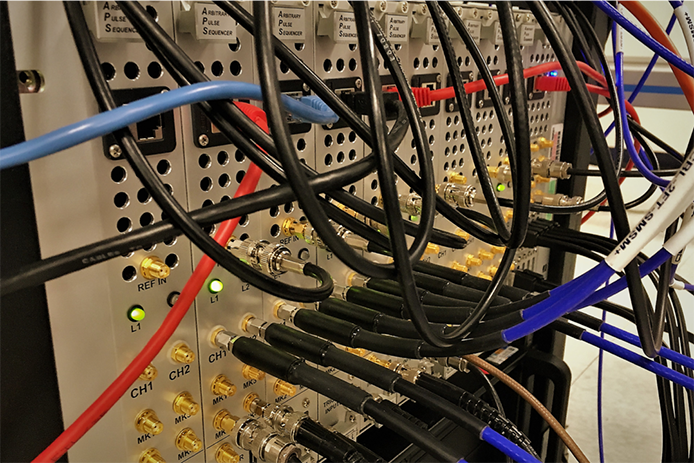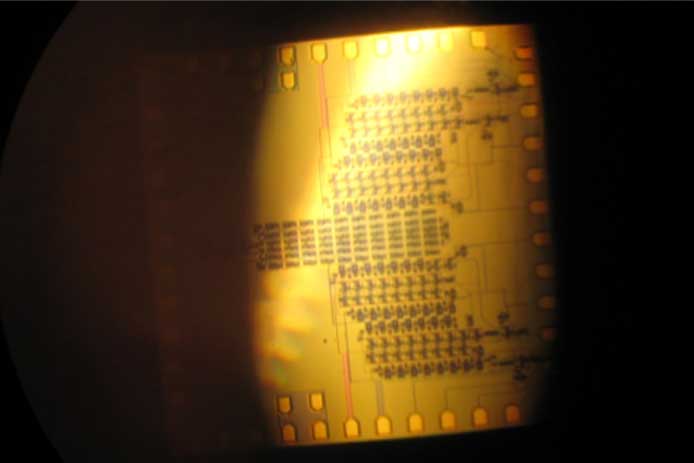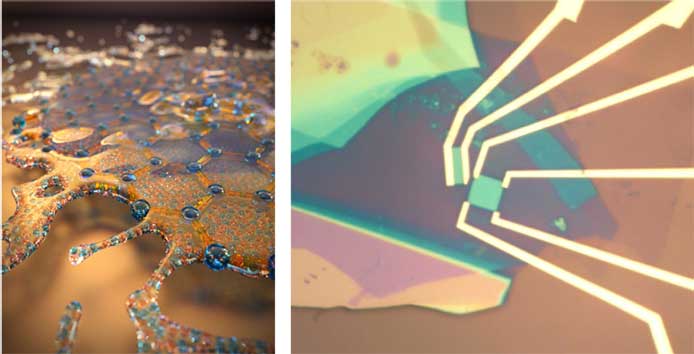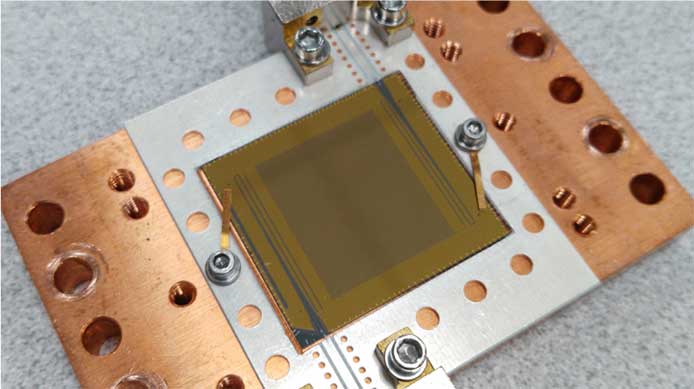Quantum engineering is an emerging field that fuses physics, engineering and computer science. It incorporates radical new ideas for computing, materials, devices and sensors. Our Quantum Engineering and Computing team is developing this next generation technology, and exploring new ways to apply it to computing, sensing, and communication.

Quantum Computing
Superconducting Qubits
Scientists in our cryogenics laboratory are studying qubit systems based on superconducting-circuits. These systems are cooled to milli-Kelvin temperatures and controlled with fast microwave electronics.
 To meet the demands for complex experiments, we have developed custom microwave hardware called the arbitrary pulse sequencer, or APS, to control a large number of qubits with complex gate sequences. We have also developed a low-latency feedback system with a field-programmable gate array for determining the state of our quantum circuit – a key capability for implementing error correction.
To meet the demands for complex experiments, we have developed custom microwave hardware called the arbitrary pulse sequencer, or APS, to control a large number of qubits with complex gate sequences. We have also developed a low-latency feedback system with a field-programmable gate array for determining the state of our quantum circuit – a key capability for implementing error correction.
Quantum Process Verification
As current quantum devices grow in size, existing techniques to diagnose error and characterize operations become impractical. We are developing novel approaches to verification and characterization of quantum devices that can be practically applied to present day devices, and those expected in the near future. These developments include approximate approaches to characterization, and system-wide benchmarks.
Quantum Algorithms
Our work in quantum algorithms spans two key areas:
- Quantum walk algorithms, which are useful for optimization problems
- Quantum algorithms for the physics simulation such as plasma dynamics and other high energy physics models
Quantum Control

Our team develops hardware, gateware and software for dynamic quantum information processing experiments with superconducting qubits. In dynamic experiments, qubit state information is used to change the implemented control sequence in real-time.
Classical Cryogenic Computing
Quantum Control with Cryoelectronics

To build a superconducting quantum computing system, qubits, as well as surrounding classical electronics, must be scalable. We have reported on a key supporting classical technology for microwave controlled superconducting qubits that would enable scaling of a quantum computer beyond impending I/O heat load and bandwidth bottlenecks. And we are exploring applications of scalable cryogenic technologies for qubit systems that include cryogenic digital logic, such as SFQ technology and
superconducting microwave components.
High-speed, Low-power, Memory for Cryo-computing

We are exploring low-power memory technologies, including the integration of superconducting circuits with spintronics. Spintronics systems include spin orbit transfer ferromagnetic memory, which can operate at superconducting circuit temperatures while providing fast, high-density, low-power random access memory located near cryogenic processors.
Quantum Materials
Research in materials science is a key propellant for technological advancement. To face the demands for increasing computational power and sensing capabilities, we study emerging 2D materials with quantum properties that can be exploited in novel electronic devices

One of these wonder materials is graphene, an atomically thin mesh of carbon atoms through which electrons can move relativistically as if they possess no mass. Making use of the minute specific heat of these electrons, our research shows that graphene can detect photons with high sensitivity in wide bandwidth, from microwave to infrared frequencies. In addition, we now have the ability to stack layers with different characteristics into complex heterostructures that can be matched within one device to suit the intended application. We are also exploring new states in Josephson junctions integrated with topological materials.
Quantum Devices and Sensors
Quantum-limited Amplifiers
In order to perform high fidelity readout and control superconducting qubits, it is necessary to have microwave devices that can amplify quantum signals with low noise and insertion loss.
At Raytheon we are studying parametric amplifiers that have a wide amplification bandwidth of several gigahertz and high saturation power. This enables the amplification of multiple readout tones at different frequencies.
Novel Non-reciprical Microwave Components

We are also studying different applications of parametric interactions. By exploiting the interference between multiple parametric processes in the same device, we obtain directional amplification and nonreciprocal propagation on a superconducting chip. While commercial RF circulators are usually used for this purpose, they are bulky and noisy components that cannot be integrated with our quantum devices.
Optics and Integrated Photonics
Our group researches optics and integrated photonics for a broad range of application areas both in the classical and quantum domains of sensing, computing, signal processing, communications, and metrology. Examples of ongoing research projects for the aforementioned applications areas are:
- Electro-optic classical/quantum transducers and sensors
- III-Nitride integrated photonics
- Silicon photonics for classical/quantum signal processing, I/O, analog RF
- Chip-scale frequency combs for PNT
- Chip-scale free-space communications
- Developing heterogeneous electronic/photonic platforms
- Integrated photonics at cryogenics

